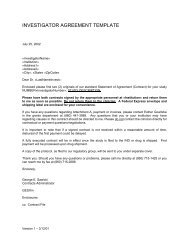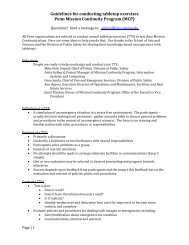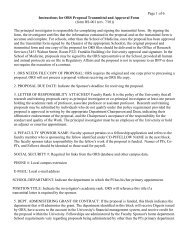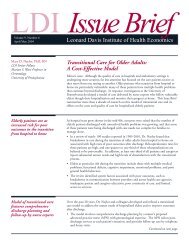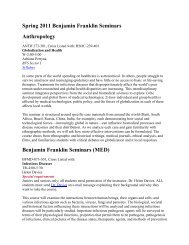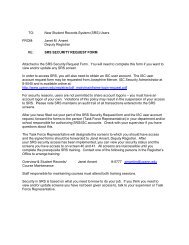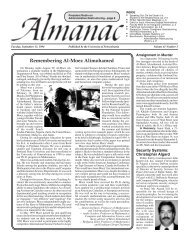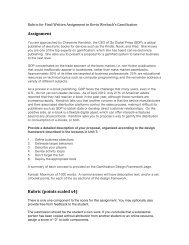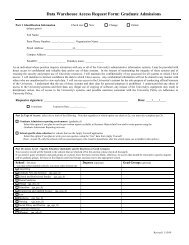PENNPRINTOUT - University of Pennsylvania
PENNPRINTOUT - University of Pennsylvania
PENNPRINTOUT - University of Pennsylvania
You also want an ePaper? Increase the reach of your titles
YUMPU automatically turns print PDFs into web optimized ePapers that Google loves.
The Wharton Research Data System<br />
Information<br />
at your fingertips<br />
BY KENDALL WHITEHOUSE AND PAUL J. RATNARAJ<br />
One <strong>of</strong> the most compelling visions <strong>of</strong> modern<br />
computing is the promise <strong>of</strong> easy access to vast<br />
data resources. Micros<strong>of</strong>t’s Bill Gates speaks <strong>of</strong><br />
“information at your fingertips” and former Apple CEO<br />
John Scully envisioned a “knowledge navigator” automatically<br />
sifting through vast data repositories.<br />
Such ideas, while deceptively easy to imagine, are<br />
<strong>of</strong>ten difficult to achieve. At the Wharton School, a<br />
program to bring large financial data sets to faculty and<br />
students—The Wharton Research Data System—has taken<br />
a significant step toward making easy access a reality.<br />
The financial data sets widely used at Wharton include<br />
market research data (such as CRSP, Fama, and Market<br />
Indices), corporate data (such as Compustat), and banking<br />
and insurance data (such as Best and FDIC). Together, the<br />
principal data sets used at Wharton occupy over 12<br />
gigabytes <strong>of</strong> storage space.<br />
Once the exclusive province <strong>of</strong> Finance and Accounting,<br />
these data sets are now used in Management, Marketing,<br />
and other Wharton departments. Wharton data sets<br />
range from examining world-wide investment patterns to<br />
handicapping the box-<strong>of</strong>fice success <strong>of</strong> upcoming motion<br />
pictures. Increasingly, faculty at Wharton also use the data<br />
sets for instructional coursework assignments.<br />
The way things were<br />
Data sets have been used at Wharton for many years;<br />
however, previous methods for delivering data were far<br />
from ideal. In the past, data sets were stored on large<br />
VAX/VMS systems, and users had to run Fortran programs<br />
to analyze or extract data. An increasing number <strong>of</strong> users,<br />
however, preferred working with familiar desktop tools<br />
such as Minitab or a spreadsheet program. But working<br />
with the data using desktop tools required that the user be<br />
familiar with the formats <strong>of</strong> the data sets, the VMS<br />
operating system, Fortran programming, mainframe to PC<br />
file transfer techniques, and the data import format <strong>of</strong><br />
desktop s<strong>of</strong>tware. As Michael Phelan, Associate Pr<strong>of</strong>essor<br />
<strong>of</strong> Statistics, points out, these data access techniques were<br />
“functional, but not for the timid.”<br />
Not only was the approach cumbersome for faculty<br />
and students, it was difficult for Wharton’s computing staff<br />
to support. To increase access speed, Wharton wrote inhouse<br />
indexing programs. To help new users, Wharton<br />
provided interactive modules and help screens. Changes in<br />
data format required updating everything written in-house<br />
and extensive in-house programming support.<br />
For all the effort required, users—accustomed to<br />
point-and-click graphical interfaces on personal computers—were<br />
increasingly dissatisfied with this arcane,<br />
multiple-step procedure.<br />
Alternatives considered<br />
Several alternatives were considered to provide easier<br />
access and improved data set management. Developing<br />
an in-house system would be costly, time-consuming,<br />
and difficult to maintain as the technology changed.<br />
Commercial database management systems provide excellent<br />
data management capabilities and convenient access<br />
tools, but most lack strong analytical tools and are not<br />
suitable for time-series data. Commercial data access<br />
packages such as Fame, DART, and Intelligent Query <strong>of</strong>fer<br />
good data manipulation tools, but also lack sophisticated<br />
analytical abilities and require extensive programming<br />
to convert the wide selection <strong>of</strong> data sets used at the<br />
Wharton School.<br />
The new architecture<br />
The solution implemented in the Wharton Research<br />
Data System involves the following components:<br />
• Using SAS (and SAS/ASSIST) to extract and<br />
analyze data<br />
• Managing data sets centrally while providing network<br />
access (through NFS mounting) to the complete series<br />
<strong>of</strong> data on UNIX systems throughout Wharton<br />
• Providing X-Window access to UNIX systems<br />
from Wharton’s labs and classroom teaching<br />
stations (continued on next page)<br />
APRIL 1995 5




